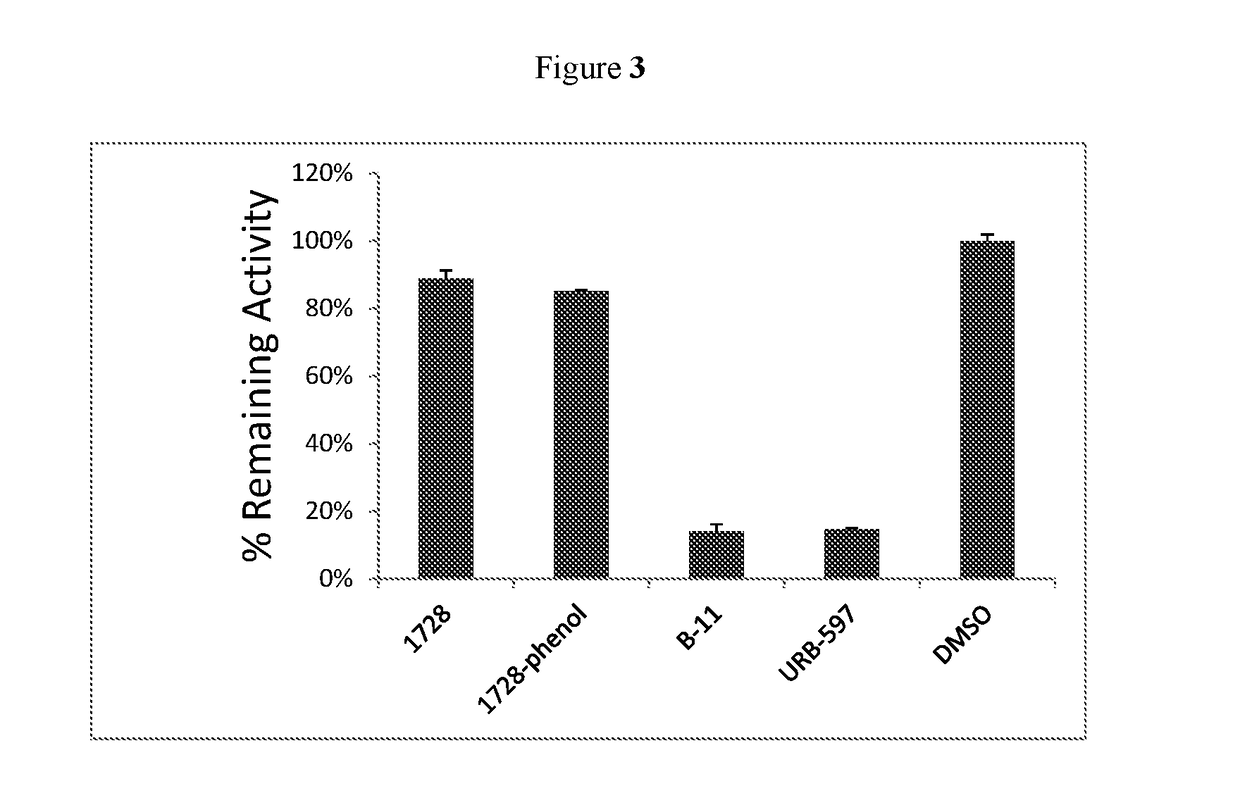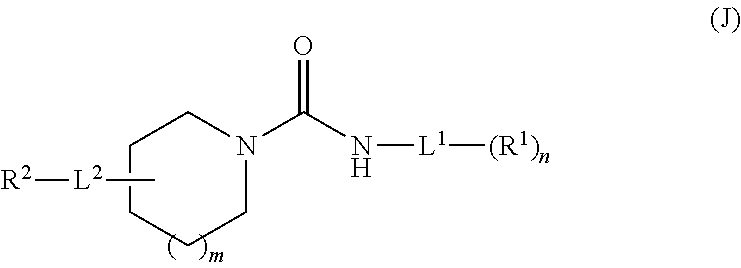Inhibitors for soluble epoxide hydrolase (SEH) and fatty acid amide hydrolase (FAAH)
- Summary
- Abstract
- Description
- Claims
- Application Information
AI Technical Summary
Benefits of technology
Problems solved by technology
Method used
Image
Examples
example 1
trans-4-(3-phenylureido)cyclohexyl)oxy)benzoic acid
[0141]
[0142]The starting material (4-((trans-4-aminocyclohexyl)oxy)benzoic acid) was prepared as previously described (Hwang et al, (2013) Bioorg. Med. Chem. Lett., 23:3732). To a solution of 4-((trans-4-aminocyclohexyl)oxy)benzoic acid (121 mg, 0.51 mmol) in dimethyl formamide (DMF, 10 mL) was added phenyl isocyanate (82 mg, 0.69 mmol). The reaction was allowed to stir overnight at which point ethyl acetate (EtOAc) and a solution of 1 M Na2CO3 was added and the aqueous layer was separated. A solution of 1 N HCl was added to the aqueous layer until pH=2 and the precipitates were filtered. The resulting product (103 mg, 0.29 mmol, 57%) was used without further purification. Melting point (MP)=241.2-252.9 (244.0°) C 1H NMR (400 MHz, DMSO-d6) δ 12.60 (s, 1H), 8.29 (s, 1H), 7.87 (d, J=8.5 Hz, 2H), 7.37 (d, J=8.0 Hz, 2H), 7.21 (t, J=7.7 Hz, 2H), 7.02 (d, J=8.6 Hz, 2H), 6.87 (t, J=7.4 Hz, 1H), 6.13 (d, J=7.5 Hz, 1H), 4.49-4.41 (b, 1H), 3....
example 2
trans-4-(3-(4-fluorophenyl)ureido)cyclohexyl)oxy)benzoic acid
[0143]
[0144]The starting material (4-((trans-4-aminocyclohexyl)oxy)benzoic acid) was prepared as previously described (Hwang et al, (2013) Bioorg. Med. Chem. Lett., 23:3732). To a solution of 4-((trans-4-aminocyclohexyl)oxy)benzoic acid (128 mg, 0.54 mmol) in DMF (10 mL) was added 4-fluorophenyl isocyanate (81 mg, 0.59 mmol). The reaction was allowed to stir overnight at which point EtOAc and a solution of 1 M Na2CO3 was added and the aqueous layer was separated. A solution of 1 N HCl was added to the aqueous layer until pH=2 and the precipitates were filtered. The resulting product (47 mg, 0.13 mmol, 23% yield) was used without further purification. MP=237.1-248.6 (242.3°) C 1H NMR (400 MHz, DMSO-d6) δ 12.58 (s, 1H), 8.56 (s, 1H), 7.84 (d, J=8.8 Hz, 2H), 7.36 (dd, J=9.1, 5.0 Hz, 2H), 7.07-6.96 (m, 4H), 6.27 (d, J=7.6 Hz, 1H), 4.46-4.39 (m, 1H), 3.55-3.46 (m, 1H), 2.02 (d, J=12.4 Hz, 2H), 1.90 (d, J=13.1 Hz, 2H) 1.50-1.29 ...
example 3
-(3-(4-(trifluoromethoxy)phenyl)ureido)butoxy)benzoic acid
[0145]
[0146]To a flask containing 4-aminobutanol (1.035 g, 11.6 mmol) in tetrahydrofuran (THF, 100 mL) was added 4-trifluoromethoxyphenyl isocyanate (2.516 g, 12.4 mmol) dropwise. The reaction was allowed to stir overnight and was quenched by the addition of 0.1 M HCl (50 mL). The product was extracted with EtOAc (100 mL), dried over MgSO4 and evaporated. The resulting solid was crystallized in EtOAc / methanol (MeOH), filtered and the filtrate was crystallized again in Hexane / EtOAc. The combined solids were collected to yield 1-(4-hydroxybutyl)-3-(4-(trifluoromethoxy)phenyl)urea without further purification (2.550 g, 8.7 mmol, 75% yield). MP=117.2-117.9° C. (117.9° C.) 1H 400 MHz NMR (DMSO-d6): 8.62 (s, 1H), 7.48 (d, J=8.8 Hz, 2H), 7.20 (d, J=8.8 Hz, 2H), 6.17 (t, J=5.6 Hz, 1H), 3.40 (t, J=6.0 Hz, 2H), 3.08 (q, J=6.0 Hz, 2H), 1.44 (t, J=6.8 Hz, 4H).
[0147]To a solution containing 1-(4-hydroxybutyl)-3-(4-(trifluoromethoxy)phenyl...
PUM
| Property | Measurement | Unit |
|---|---|---|
| weight | aaaaa | aaaaa |
| weight | aaaaa | aaaaa |
| weight ratio | aaaaa | aaaaa |
Abstract
Description
Claims
Application Information
 Login to View More
Login to View More - R&D
- Intellectual Property
- Life Sciences
- Materials
- Tech Scout
- Unparalleled Data Quality
- Higher Quality Content
- 60% Fewer Hallucinations
Browse by: Latest US Patents, China's latest patents, Technical Efficacy Thesaurus, Application Domain, Technology Topic, Popular Technical Reports.
© 2025 PatSnap. All rights reserved.Legal|Privacy policy|Modern Slavery Act Transparency Statement|Sitemap|About US| Contact US: help@patsnap.com



